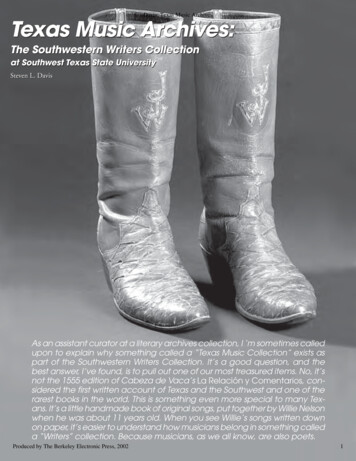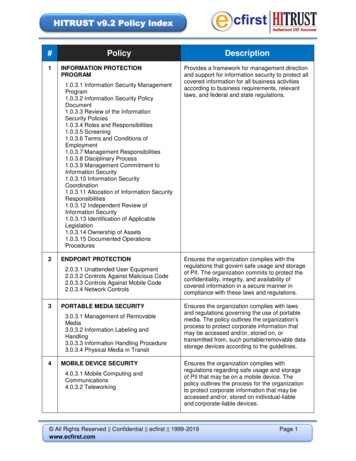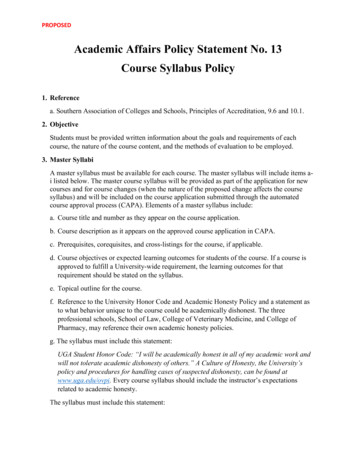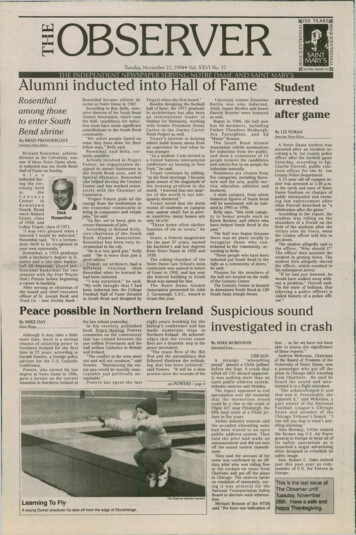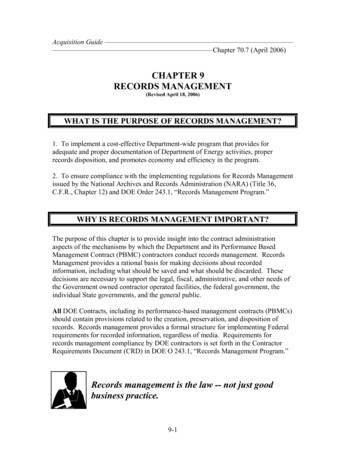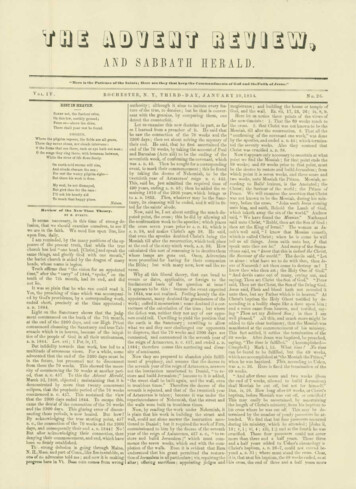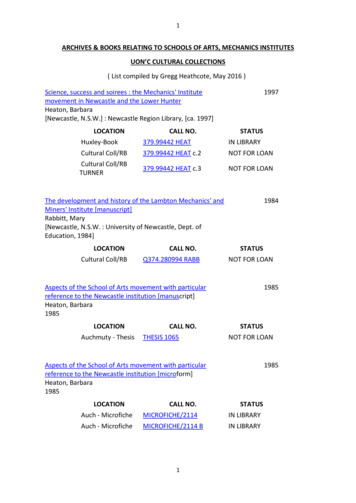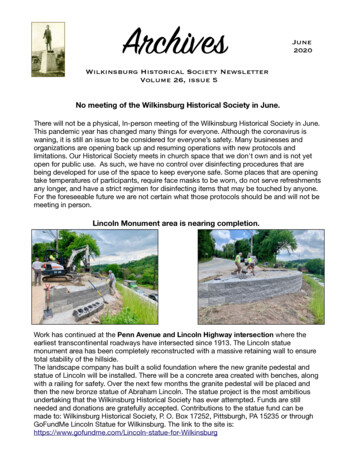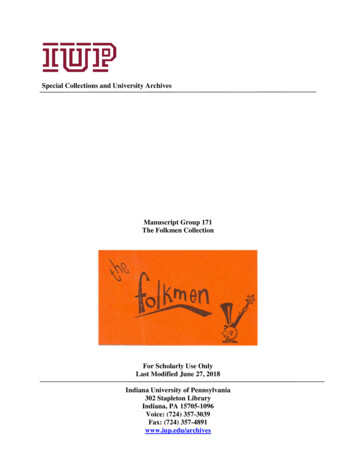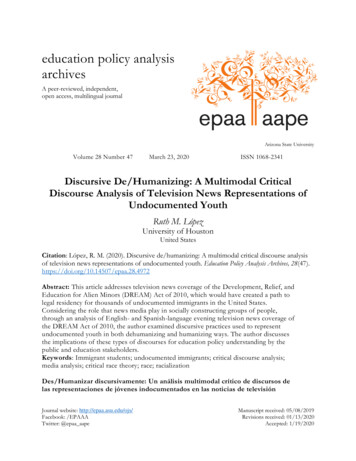
Transcription
education policy analysisarchivesA peer-reviewed, independent,open access, multilingual journalArizona State UniversityVolume 28 Number 47March 23, 2020ISSN 1068-2341Discursive De/Humanizing: A Multimodal CriticalDiscourse Analysis of Television News Representations ofUndocumented YouthRuth M. LópezUniversity of HoustonUnited StatesCitation: López, R. M. (2020). Discursive de/humanizing: A multimodal critical discourse analysisof television news representations of undocumented youth. Education Policy Analysis Archives, ct: This article addresses television news coverage of the Development, Relief, andEducation for Alien Minors (DREAM) Act of 2010, which would have created a path tolegal residency for thousands of undocumented immigrants in the United States.Considering the role that news media play in socially constructing groups of people,through an analysis of English- and Spanish-language evening television news coverage ofthe DREAM Act of 2010, the author examined discursive practices used to representundocumented youth in both dehumanizing and humanizing ways. The author discussesthe implications of these types of discourses for education policy understanding by thepublic and education stakeholders.Keywords: Immigrant students; undocumented immigrants; critical discourse analysis;media analysis; critical race theory; race; racializationDes/Humanizar discursivamente: Un análisis multimodal crítico de discursos delas representaciones de jóvenes indocumentados en las noticias de televisiónJournal website: http://epaa.asu.edu/ojs/Facebook: /EPAAATwitter: @epaa aapeManuscript received: 05/08/2019Revisions received: 01/13/2020Accepted: 1/19/2020
Education Policy Analysis Archives Vol. 28 No. 472Resumen: Este artículo se enfoca en la cobertura de los noticieros televisivos sobre lapropuesta Development, Relief, and Education for Alien Minors (DREAM) Act of 2010, quehubiera creado un paso hacia la residencia legal para miles de inmigrantes indocumentadosen los Estados Unidos (EEUU). Considerando el papel que los medios de comunicaciónnoticieros juegan en construir socialmente a grupos de personas, a cabo de un análisis denoticieros televisivos en español e inglés que cubrieron el DREAM Act of 2010, la autoraexaminó prácticas discursivas utilizadas para representar a jóvenes indocumentados demaneras que deshuminarizaron y humanizaron a este grupo. La autora discute lasimplicaciones de estos tipos de discursos para el conocimiento de la política de educaciónpor el público y para personas involucradas (stakeholders) en el sistema educativo.Palabras-clave: Estudiantes inmigrantes; inmigrantes indocumentados; análisis crítico dediscurso; análisis de medios de comunicación; teoría racial crítica; raza; racializaciónDes/Humanizar discursivamente: Uma análise dissertativa crítica multimodal a respeito derepresentações televisivas sobre jovens indocumentados em noticiáriosResumo: Este artigo centra-se na cobertura televisiva de notícias feita sobre a proposta Development,Relief, and Education for Alien Minors (DREAM) Act of 2010, que criaria um caminho em direção àresidência legal para milhares de imigrantes indocumentados nos Estados Unidos da América(EUA). Tendo em consideração o papel que os meios de comunicação de notícias desempenham naconstrução social de grupos de pessoas, a partir de uma análise das notícias de televisão quecobriram o DREAM Act of 2010 em espanhol e inglês, a autora examinou práticas discursivas usadaspara representar jovens indocumentados de maneiras que desumanizam e humanizam esse grupo. Aautora analisa as implicações desses modelos de discurso no entendimento de políticas de educaçãopara o público e para pessoas diretamente envolvidas (stakeholders) no sistema educacional.Palavras-chave: Estudantes imigrantes; imigrantes indocumentados; análise crítica de discurso;análise de meios de comunicação; teoria racial crítica; raça; racialização
Discursive De/Humanizing3IntroductionImmigration was one of the most prevalent and divisive issues noted during the 2016Presidential election. During Donald Trump’s first year in office, immigration continued to be acenterpiece of his agenda as he signed a far-reaching ban on immigration, which prompted protestsat airports nationwide (ACLU-Washington, 2018). Moreover, he touted and implemented plans for aborder wall between the United States and Mexico (Taylor, 2019), and inflamed anti-immigrantsentiment with racist language (López & Matos, 2018). More recently, his administration isresponsible for the separation and inhumane detention of asylum-seeking families from CentralAmerica (Bala & Rizer, 2019). This political context has been covered in the mass media, and mediacoverage of issues like this shape the ways the public responds to immigration issues and immigrants(Gil de Zúñiga, Correa, & Valenzuela, 2012). However, it is important to note that this currentcontext is connected to and preceded by a long history of anti-immigrant and anti-Mexicansentiment (Menchaca, 1993).Focusing on an issue that gained attention in 2001, this paper addresses the television newscoverage of one of the most publicized policies related to U.S. immigration and education: TheDevelopment, Relief, and Education for Alien Minors (DREAM) Act. Following the 1982 Plyler v.Doe Supreme Court decision, undocumented children gained the right to a free public K-12education in the United States (Olivas, 2012b), but their access to higher education and immigrationstatus were left largely unaddressed (López, 2004). In response to the uncertain futures faced bythousands of undocumented youth upon high school graduation each year, the DREAM Act wasfirst introduced to Congress in 2001 (Olivas, 2004). If passed, this Act would have created a path tolegal residency for young undocumented immigrants, sometimes referred to as “DREAMers,”1 livingin the United States who met a number of requirements including earning a high school diploma orGED, college attendance or serving in the military. Today, the issue remains relevant and unresolvedin politics, education, and the public sphere, and most importantly, undocumented youth and theirfamilies continue living with much uncertainty (Gonzales, 2015; Olivas, 2013).PurposeThe recent political and anti-immigrant context that impacts the lives of undocumented andmixed-status families in this country underscores the timeliness of this study that examines the socialconstruction of undocumented youth in English- and Spanish-language evening television newscoverage of the DREAM Act of 2010.2 Considering Haas’ (2004) argument that news media play alarge part in how education policy issues come to be understood by the public, I examined howframing was used to represent undocumented youth. More specifically, I explored the followingquestion: How were undocumented youth socially constructed in television news? To explore myresearch question, I conducted a multimodal (Kress, 2011) critical discourse analysis (CDA; Luke,1995; van Dijk, 2002, 2003). I argue that public understanding of the DREAM Act andundocumented immigrants was influenced by media coverage of this topic. In education, thisThroughout this report, I refer to the group who would benefit from the DREAM Act as DREAMers andundocumented youth, but it is important to note that not all undocumented youth refer to themselves asDREAMers. Additionally, depending on the age requirements of different versions of the policy, not allundocumented youth qualified for the DREAM Act.2Although social media news consumption is steadily on the rise (Pew Research Center, 2015), eveningtelevision news continues to be the main source of news for many and during the time this study focuses on,several evening news networks experienced higher ratings (Bauder, 2011).1
Education Policy Analysis Archives Vol. 28 No. 474framing has implications for how education stakeholders come to understand the immigrantstudents they serve and the policies that affect them.Background and Literature ReviewPolicies Targeting Undocumented YouthAlong with the federal policy issues mentioned above, state-level education policies have alsoimpacted undocumented college-age youth. From the time the DREAM Act was first debated inCongress in 2001, 18 states passed in-state tuition legislation, which do not create a path tocitizenship but do allow undocumented individuals to pay lower college tuition rates thaninternational or out-of-state students (Olivas, 2004).On a federal level, since its introduction, the DREAM Act has been close to passing multipletimes, on varying occasions receiving bi-partisan support (Barron, 2011). However, during formerPresident Barack Obama’s first year as President in 2009, the DREAM Act largely lost support ofthe Republican Party. This loss of bipartisan support occurred at a time in this country’s historywhen immigration supporters continued to await the passage not only of the DREAM Act, but alsoof a larger comprehensive immigration reform (CIR) that could affect many, including the parents ofthe undocumented youth (Olivas, 2013). Although there was hope that CIR would be passed duringPresident Obama’s first term, this was not the case. On the contrary, the last decade has beenmarked by strong anti-immigrant sentiments all throughout the United States, made evident by thepassage of several state bills targeting immigrants in states such as Arizona, Alabama, and Georgiabeginning in 2010 (Fryberg et al., 2011; Noriega & Iribarren, 2011; Olivas, 2013), and most recentlyin Texas through Senate Bill 4, that requires local police to cooperate with federal immigrationauthorities (Svitek, 2017).From 2009 to 2012, during President Obama’s first term, the highest number of DREAMAct proposals in Congress occurred in 2010, with eight versions of the DREAM Act proposedeither as amendments to larger bills or as stand-alone bills. For example, at one point the DREAMAct of 2010 was included as part of a defense spending bill along with the repeal of “Don’t Ask,Don’t Tell.” Ultimately, in December of 2010, the DREAM Act (H.R. 1528, 2010) almost passedwhen it was approved in the House and failed by only five votes in the Senate. Even with theirDemocratic advantage, due to a Republican rule, the Democrats needed 60 “yes” votes in the Senatein order for the Senate version, S. 3992 to pass, which they did not receive (Olivas, 2012a).Although on a federal level the DREAM Act failed, on June 15, 2012, President Obamaissued an executive order called Deferred Action for Childhood Arrivals (DACA) that grantedstudents eligible for the DREAM Act a renewable 2-year work permit and a Social Security number;in some states this also meant they were eligible to receive a driver’s license (Olivas, 2012a, 2013). Itis estimated that 1.2 million individuals immediately qualified under this executive order, and as ofJuly 2014, 587,000 individuals were granted deferred action (Batalova, Hooker, & Capps, 2014).Although this order granted opportunities to many, undocumented youth still face a dilemmaconsidering their long-term uncertainty without the passage of CIR (Olivas, 2013). Subsequently,with President Obama’s re-election in 2012 and with over 70 percent of Latino voters supportinghim (Foley, 2012), many expected increased activities related to the DREAM Act legislation andCIR, but this was not the case. In November 2014, President Obama announced an expansion tothe DACA program and a new program, Deferred Action for Parents of Americans and LawfulPermanent Residents (DAPA), which would protect parents of United States citizens and legalpermanent residents from deportation. Both DAPA and the DACA expansion were blocked frombeing implemented by a federal district court in Texas. Then on September 5, 2017, President
Discursive De/Humanizing5Trump rescinded DACA, although it currently still stands after litigation, and the possibility of theDREAM Act passing continues to be part of the national dialogue.These state- and federal-level policies have direct implications for an estimated 98,000undocumented students who graduate high school each year and the more than 680,000 who holdDACA status (Zong & Batalova, 2019)—not to mention the undocumented young adults who agedout of DACA and would not be included in DREAM Act as it has been proposed previously. Giventhis reality, the public and education stakeholders’ (i.e. teachers, administrators, other educators,education researchers, policymakers) understanding of these policies is critical.Media Framing of Immigrants & the Latinx Community 3According to Lakoff & Ferguson (2006), “frames structure the way we think, the way wedefine problems, the values behind the definitions of those problems, and what counts as ‘solutions’to those frame-defined problems” (para. 2). One of the most obvious ways the “problem” ofimmigration has been framed in the media is by referring to undocumented immigrants as the term“illegal.” Several scholars argue that the use of this term represents anti-immigrant ideologies(Noriega & Iribarren, 2011; Pérez Huber, Lopez, Malagon, Velez, & Solórzano, 2008). Noriega andIribarren (2011) for example, found in their qualitative content analysis of talk radio that a new kindof “hate speech” was often used in the language surrounding Latinos, people of color in publicoffice, undocumented immigrants, and immigration. In one segment of the Lou Dobbs Show, theyfound that the word “illegal” was used 44 times (p. 9). Within the political sphere, there have beenseveral attempts to remove the words “illegal” and “alien” from official government policydocuments—the most recent being proposed in 2019 by Congressman Joaquín Castro (H.R. 3776,2019). There is a need to critically analyze this type of dehumanizing language and how it hasbecome more prevalent in the last decade.In his CDA of newspaper representations of Latinos, Santa Ana (2002) employed cognitivem
Immigration was one of the most prevalent and divisive issues noted during the 2016 Presidential election. During Donald Trump’s first year in office, immigration continued to be a centerpiece of his agenda as he signed a far-reaching ban on immigration, which prompted protests at airports nationwide (ACLU-Washington, 2018). Moreover, he touted and implemented plans for a
